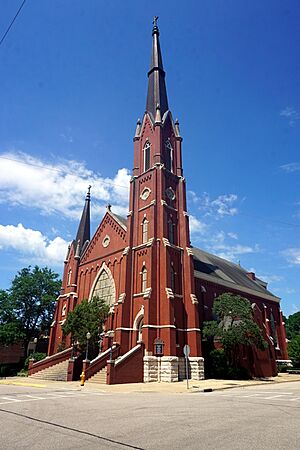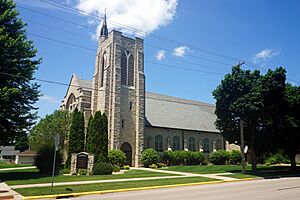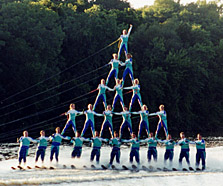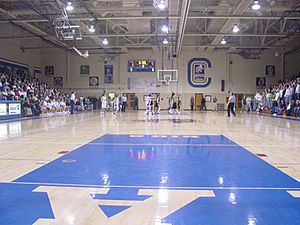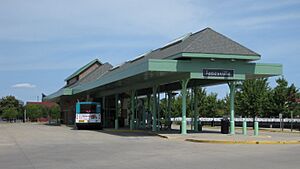Janesville, Wisconsin facts for kids
Quick facts for kids
Janesville, Wisconsin
|
||
|---|---|---|
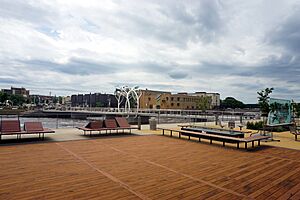
Town Square in downtown Janesville
|
||
|
||
| Nickname(s):
"Wisconsin's Park Place", "Bower City"
|
||
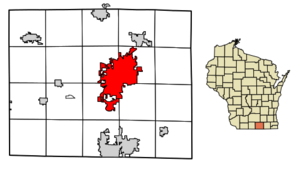
Location of Janesville in Rock County, Wisconsin.
|
||
| Country | United States | |
| State | Wisconsin | |
| County | Rock | |
| Incorporated | 1853 | |
| Area | ||
| • City | 34.76 sq mi (90.03 km2) | |
| • Land | 34.16 sq mi (88.47 km2) | |
| • Water | 0.60 sq mi (1.56 km2) | |
| Population
(2020)
|
||
| • City | 65,615 | |
| • Rank | 10th in Wisconsin | |
| • Density | 1,890.37/sq mi (729.87/km2) | |
| • Metro | 160,092 | |
| Time zone | UTC−6 (Central) | |
| • Summer (DST) | UTC−5 (CDT) | |
| ZIP Codes |
53545–53548
|
|
| Area code(s) | 608 | |
| FIPS code | 55-37825 | |
| Website | www.janesvillewi.gov | |
Janesville is a city in Rock County, Wisconsin, United States. It is also the county seat, which means it's where the main government offices for the county are located.
In 2020, about 65,615 people lived in Janesville. This makes it the tenth-largest city in Wisconsin. Janesville is a main city in the larger Janesville–Beloit area. This area includes all of Rock County.
Contents
History of Janesville
Before American settlers arrived, the Janesville area was home to many Native Americans. Tribes like the Ho-Chunk and Potawatomi lived here. In the 1830s, many Native American groups were forced to leave their homes. This happened because of laws like the Indian Removal Act. They had to move to reservations to make space for new settlers.
Early Settlement and Founding
In 1835, some American settlers built a simple log cabin in the area. Later that year, a key settler named Henry Janes arrived. He was from Virginia and was known as a woodsman and city planner. Janes wanted to name the new village "Blackhawk" after the famous Sauk leader Chief Black Hawk. However, government officials did not approve this name.
After some talks, they decided to name the town after Janes himself. So, in 1835, Janesville was founded. Many early settlers came from New England and upstate New York. They were looking for good farmland and woodlands. These pioneers started farms and grew crops like wheat.
Growth and Industry Development
As more people moved to Janesville, new businesses started. These included flour and lumber mills along the Rock River. The first dam was built in 1844.
Some settlers came from western New York, an area known for religious and social movements. These groups were active in fighting against slavery and for women's rights.
William Tallman, from Rome, New York, moved to Janesville in 1850. He bought a lot of land and encouraged others to settle in Rock County. Tallman became a very important person in Janesville. He strongly supported the fight against slavery and the Republican Party. In 1859, he convinced Abraham Lincoln, who was becoming famous, to speak in Janesville. Today, the Tallman house is a historic landmark. It is known as "The place where Abraham Lincoln slept."
Janesville During the Civil War
Janesville played a big part in the American Civil War. Local farms sold grains to the Union army. Rock County had many men who joined the army. Thomas H. Ruger from Janesville became a brigadier general. He later served as military governor of Georgia. He was also the leader of West Point.
Post-Civil War Changes
After the Civil War, farming in Janesville kept growing. Farmers needed new tools, which led to factories making farm machines. Companies like Janesville Machine Company started. With new railroads, Janesville could ship goods to big cities like New York and Boston.
Over time, the soil became less fertile for grain. Farmers then started growing tobacco, which became a very successful crop in Wisconsin.
Women's Rights and German Immigration
A women's rights movement began in Janesville in the 1850s. After the Civil War, this group continued its work. In the 1870s, they focused on the Temperance movement, which aimed to reduce alcohol use.
In the late 1880s, many German immigrants came to Janesville. They were welcomed by the people already living there. This led to more Germans moving to the town.
Modern Industry and Innovation
A big change for Janesville was the opening of a General Motors (GM) plant in 1919. It first made tractors, but later switched to making cars.
George Parker was another important person in Janesville. He created new pen designs and started the Parker Pen Company. His pens were famous worldwide. A Parker pen was used to sign the end of World War II in Europe. Another was used to sign Japan's surrender. The Parker Pen Company was a top employer for over 70 years.
John Nolen, a city planner, was hired in 1919. He helped design Janesville's parks, earning it the nickname "City of Parks."
Janesville hosted the first Wisconsin State Fair in 1851. About 10,000 people attended.
Lavinia Goodell, Wisconsin's first female lawyer, lived in Janesville in 1874.
A tree in Courthouse Park was the site of a public hanging in 1859. Today, a place where a cross burning happened in 1992 is now "Peace Park." It has a playground and a very tall peace pole.
Historic Places in Janesville
Many buildings in Janesville are listed on the National Register of Historic Places. About 20% of Wisconsin's listed buildings are here. The 1857 Lincoln–Tallman House is one of these sites. It shows the Italian Villa-style of architecture. Abraham Lincoln stayed there for two nights.
The old Janesville Public Library, built in 1902, is also on the list. It was a Carnegie library. Other historic areas include the Courthouse Hill Historic District and the Lappin-Hayes Block. The Frances Willard Schoolhouse, named after Frances Willard, is also a historic site.
Janesville City Flag
Janesville got its first flag in 2015. Students designed it in a contest. The flag shows the city's past, present, and future.
- The number 1853 is when Janesville became a city.
- Four stars stand for the city's first four areas.
- The green background shows the city's farming history.
- Black represents the rich soil and the smoke from old factories.
- The tree in the middle is the city's logo. It shows Janesville's slogan: "Wisconsin’s Park Place."
Geography of Janesville
Janesville covers about 34.45 square miles (90.03 square kilometers). Most of this is land, with a small amount of water. The city is divided by the Rock River.
People of Janesville
Population Changes Over Time
| Historical population | |||
|---|---|---|---|
| Census | Pop. | %± | |
| 1860 | 7,703 | — | |
| 1870 | 8,789 | 14.1% | |
| 1880 | 9,018 | 2.6% | |
| 1890 | 10,836 | 20.2% | |
| 1900 | 13,185 | 21.7% | |
| 1910 | 13,894 | 5.4% | |
| 1920 | 18,293 | 31.7% | |
| 1930 | 21,628 | 18.2% | |
| 1940 | 22,992 | 6.3% | |
| 1950 | 24,899 | 8.3% | |
| 1960 | 35,164 | 41.2% | |
| 1970 | 46,426 | 32.0% | |
| 1980 | 51,071 | 10.0% | |
| 1990 | 52,133 | 2.1% | |
| 2000 | 59,498 | 14.1% | |
| 2010 | 63,575 | 6.9% | |
| 2020 | 65,615 | 3.2% | |
| U.S. Decennial Census | |||
In 2020, Janesville had 65,615 people. The city had about 1,920 people per square mile. Most people were White (84.8%). Other groups included Black or African American (3.3%), Asian (1.7%), and Native American (0.4%). About 7.2% of the population was Hispanic or Latino.
The average household income was about $55,914. About 11.3% of the people lived below the poverty line. This included 14.9% of those under 18. Most adults (93.1%) had a high school diploma or higher. About 25.2% had a college degree.
Religion in Janesville
Janesville has several churches. There are four Roman Catholic churches. The oldest, St. Patrick's, started in 1844. Nativity of Mary church was built in 1902 by German immigrants. Other Christian churches include Lutheran, Methodist, and Baptist. The First Baptist Church began in 1844.
The Gideon Bible organization was founded at the Janesville YMCA in 1899. Janesville also has a mosque.
Economy of Janesville
Janesville is home to several businesses. These include Impact Confections, a candy maker, and Blain's Farm & Fleet, a retail store chain. Woodman's Markets, a supermarket chain, also started here. Hufcor makes room dividers and sells them worldwide. Gray's Brewing makes special beers and soft drinks.
General Motors Plant History
From 1919 to 2008, Janesville had a General Motors plant. It was the oldest GM plant in North America. It used to make trucks and SUVs. However, when gas prices went up, people bought fewer of these vehicles. The plant closed in December 2008.
The Parker Pen Company was also founded in Janesville. Its factory was once the biggest pen factory in the world. The company later sold its pen business, and the factory closed in 2000. Northwestern Mutual, a financial company, started in Janesville in 1857 but moved to Milwaukee two years later.
Shopping and Development
The Janesville Mall was updated in the late 1990s. A Walmart Supercenter and a Sam's Club opened in 2006. The site of the old Janesville Oasis is now being redeveloped. It was known for Bessie, a large fiberglass cow statue. Bessie was saved because people wanted her to stay.
Major Employers in Janesville
As of 2015, the biggest employers in Janesville were:
- Mercy Health System
- Janesville School District
- Rock County
- Blackhawk Technical College
- Data Dimensions Corporation
- Seneca Foods
- City of Janesville
- Prent Corporation
- Blain Supply/Blain's Farm & Fleet
- SSI Technologies
- JP Cullen & Sons
- Dean Clinic – Janesville East
- Lemans Corporation
- St Mary's Janesville Hospital
- Bliss Communications
- Chambers & Owen
- Simmons
- Hufcor
- Amtec Corporation
- Grainger
Arts and Culture in Janesville
Historic Buildings and Sites
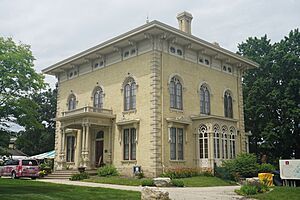
The 1857 Lincoln-Tallman House is a key historic site. It shows the Italian Villa-style of architecture. Abraham Lincoln stayed there for two nights. The Columbus Circle neighborhood became Janesville's tenth historic district in 2005.
The old Janesville Public Library, built in 1903, is considered one of the best Neoclassical Carnegie libraries in Wisconsin. Other important historic places include the Courthouse Hill Historic District and the Lappin-Hayes Block. The Lovejoy and Merrill-Nowlan Houses were homes of two Janesville Mayors. The Frances Willard Schoolhouse is named after Frances Willard.
Hedberg Public Library
The library started in 1865 as a private reading room. It became a public library in 1884. In 1903, a new building was built with money from Andrew Carnegie. A newer library was built in 1968. In 1996, it was updated and renamed Hedberg Public Library.
Sports in Janesville
In 2009, Janesville became home to the Janesville Jets. This is a hockey team in the North American Hockey League. They play their games at the Janesville Ice Arena. Janesville also had a minor league baseball team called the Janesville Cubs from 1941 to 1953.
Parks and Recreation in Janesville
Janesville is known as "Wisconsin's Park Place." It has over 2,590 acres of parks. This includes 64 improved parks, boat launches, golf courses, and nature trails. This is one of the highest amounts of park land per person in Wisconsin.
Rotary Gardens is a public botanical garden in Janesville. It was built on an old sand pit.
Other big parks include Riverside Park, which has a golf course and part of the Ice Age Trail. Rockport Park has a swimming pool. Monterey Park has the Big Rock, a natural landmark. Palmer Park has a golf course and CAMDEN Playground. This playground is designed to be accessible for everyone.
Janesville also has a large greenbelt system. This helps with water runoff and provides homes for plants and animals.
Education in Janesville
The School District of Janesville has twelve elementary schools, three middle schools, and two high schools. There are also five charter schools. In addition, Janesville has seven private elementary and middle schools and one private high school.
The Wisconsin School for the Blind and Visually Impaired has been in Janesville since 1849. The University of Wisconsin–Rock County is a two-year college in Janesville. Blackhawk Technical College is also nearby.
Media in Janesville
The Janesville Gazette is a daily newspaper that covers Janesville and the surrounding area. The Janesville Messenger is a bi-weekly paper.
Janesville has two local TV stations: WIFS (channel 57) and W65EE (channel 65). It is part of the Madison television market.
There are three main radio stations in Janesville: WCLO (news/talk), WJVL (country), and WWHG (rock).
Transportation in Janesville
Bus Services
Janesville has its own bus system called the Janesville Transit System (JTS). It also connects to Beloit. Van Galder Bus Company offers bus service between Madison and Chicago. Other companies like Megabus also serve the area.
Major Roads
Interstate 90/39 goes through Janesville. U.S. Hwy 14 and 51 also pass through. State highways Hwy 26 and 11 are here too.
Air Travel
Janesville is served by Southern Wisconsin Regional Airport (KJVL). This airport handles general aviation and cargo flights. For commercial flights, the closest airports are in Madison and Rockford, Illinois.
Rail Services
Three freight railroads serve Janesville: Union Pacific, Wisconsin and Southern Railroad, and Iowa, Chicago and Eastern Railroad. Janesville used to have passenger train service. Today, the closest passenger train is in Harvard, Illinois, which connects to Chicago.
Notable people
See also
 In Spanish: Janesville (Wisconsin) para niños
In Spanish: Janesville (Wisconsin) para niños





